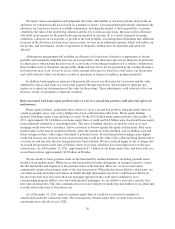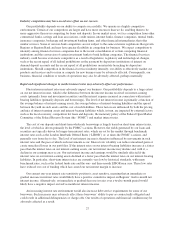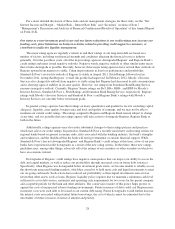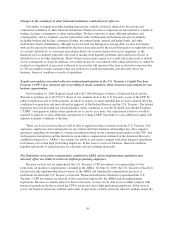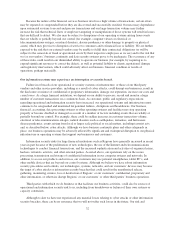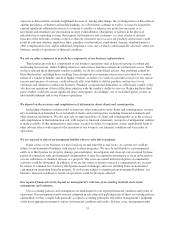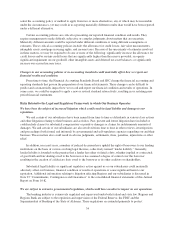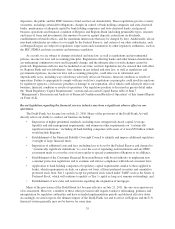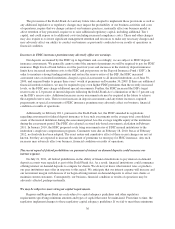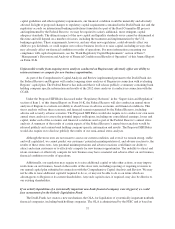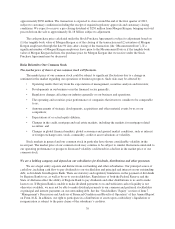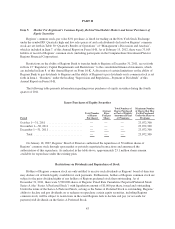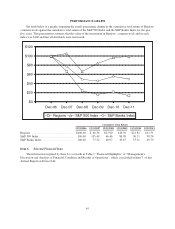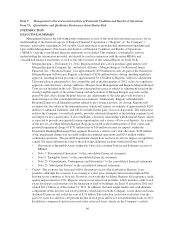Regions Bank 2011 Annual Report Download - page 60
Download and view the complete annual report
Please find page 60 of the 2011 Regions Bank annual report below. You can navigate through the pages in the report by either clicking on the pages listed below, or by using the keyword search tool below to find specific information within the annual report.The provisions of the Dodd-Frank Act and any future rules adopted to implement those provisions as well as
any additional legislative or regulatory changes may impact the profitability of our business activities and costs
of operations, require that we change certain of our business practices, materially affect our business model or
affect retention of key personnel, require us to raise additional regulatory capital, including additional Tier 1
capital, and could expose us to additional costs (including increased compliance costs). These and other changes
may also require us to invest significant management attention and resources to make any necessary changes and
may adversely affect our ability to conduct our business as previously conducted or our results of operations or
financial condition.
Increases in FDIC insurance premiums may adversely affect our earnings.
Our deposits are insured by the FDIC up to legal limits and, accordingly, we are subject to FDIC deposit
insurance assessments. We generally cannot control the amount of premiums we will be required to pay for FDIC
insurance. High levels of bank failures over the past four years and increases in the statutory deposit insurance
limits have increased resolution costs to the FDIC and put pressure on the Deposit Insurance Fund (“DIF”). In
order to maintain a strong funding position and restore the reserve ratios of the DIF, the FDIC increased
assessment rates on insured institutions, charged a special assessment to all insured institutions as of June 30,
2009, and required banks to prepay three years’ worth of premiums on December 30, 2009. If there are additional
financial institution failures, we may be required to pay even higher FDIC premiums than the recently increased
levels, or the FDIC may charge additional special assessments. Further, the FDIC increased the DIF’s target
reserve ratio to 2.0 percent of insured deposits following the Dodd-Frank Act’s elimination of the 1.5 percent cap
on the DIF’s reserve ratio. Additional increases in our assessment rate may be required in the future to achieve
this targeted reserve ratio. These recent increases in deposit assessments and any future increases, required
prepayments or special assessments of FDIC insurance premiums may adversely affect our business, financial
condition or results of operations.
Additionally, in February 2011, pursuant to the Dodd-Frank Act, the FDIC amended its regulations
regarding assessment for federal deposit insurance to base such assessments on the average total consolidated
assets of the insured institution during the assessment period, less the average tangible equity of the institution
during the assessment period. The FDIC also adopted a revised risk-based assessment calculation in February
2011. In January 2010, the FDIC proposed a rule tying assessment rates of FDIC insured institutions to the
institution’s employee compensation programs. Comments were due on February 18, 2010, but as of February
2012, no final rule has been adopted. The exact nature and cumulative effect of these recent changes are not yet
known, but they are expected to increase the amount of premiums we must pay for FDIC insurance. Any such
increases may adversely affect our business, financial condition or results of operations.
The recent repeal of federal prohibitions on payment of interest on demand deposits could increase our
interest expense.
On July 21, 2011, all federal prohibitions on the ability of financial institutions to pay interest on demand
deposit accounts were repealed as part of the Dodd-Frank Act. As a result, financial institutions could commence
offering interest on demand deposits to compete for clients. We do not yet know what interest rates or products
our peer institutions may offer in response to this repeal. We anticipate that our interest expense will increase and
our net interest margin will decrease if we begin offering interest on demand deposits to attract new clients or
maintain current customers. Consequently, our business, financial condition or results of operations may be
adversely affected, perhaps materially.
We may be subject to more stringent capital requirements.
Regions and Regions Bank are each subject to capital adequacy guidelines and other regulatory
requirements specifying minimum amounts and types of capital that must be maintained. From time to time, the
regulators implement changes to these regulatory capital adequacy guidelines. If we fail to meet these minimum
36


